2. 北京大学环境工程系, 北京 100871
2. Department of Environmental Engineering, Peking University, Beijing 100871, China
水库是一类半人工半自然的淡水水生生态系统[1], 兼具饮用、灌溉、防洪和发电等多种重要功能[2].近年来由于水质性缺水问题日益严重[3], 水库成为居民饮用水的主要来源, “河流水库化”呈现逐年增长趋势[4].水库的修建改变了天然河道的演变规律, 形成了其独特的水文特征[2].水体和沉积物环境作为水库生态系统的重要组成部分[5], 通过水中物质的沉降、沉积物中物质的分解和溶解性物质释放到开放水域等方式相互联系和影响[6].此外, 水库水质随着使用年限的增长而不断下降[7, 8], 外界环境条件的转变将直接威胁生物多样性[9], 对生态系统的可持续发展造成严重危害[2], 水质健康状况也直接影响居民的生命健康安全及饮用水处理成本[10].因此, 系统性地研究水库生境有助于加深对水库生态系统结构和特性的认识理解, 以期为保护及合理利用水库水资源提供科学依据.
细菌是水库生态系统的重要组成成分之一, 在生物地球化学循环过程中发挥着不可替代的作用[11].细菌可以驱动生态系统的物质代谢和能量转换[3, 12], 是食物链和食物网的关键一环, 也是水环境中的主要消费者和分解者, 在水库水体和沉积物环境中分布广泛、数量众多且种类繁复[11], 对于水库生态系统的稳定具有重要的环境学意义[13].有研究表明, 水库的水文特征与其他水生环境存在一定区别, 从而形成了独特的细菌群落组成和结构[14], 且细菌群落紧密联系水体和沉积物环境, 在两者间的物质能量循环交换过程中起到尤为关键的作用[15, 16].Wang等[17]对三峡水库细菌群落进行分析, 发现多样性沿水流方向积累, 并最终于库区下游收敛, 表明水库对细菌具有累积效应.同时, 水库建造过程中筑坝拦截泥沙, 沉积物性质发生改变, 从而影响沉积物细菌群落的结构和功能.Wu等[18]分析了长江筑坝建库前后沉积物环境的变化, 结果表明水库的建设是造成沉积物细菌群落结构发生显著变化的根本原因.此外, 水库细菌对环境变化敏感且响应迅速, 常作为指示生物反映水体的水质健康状况[11, 13], 在维持水库生态系统功能和健康方面起到关键性作用[19].因此, 研究水库生态系统细菌群落演替对于水资源保护具有重要意义.目前, 水库细菌群落的相关研究主要集中于某一类生物指示种如大肠杆菌的研究中[20, 21], 或针对水体细菌群落及其影响因素进行分析[22], 而对于沉积物中细菌群落的研究还处于起步阶段, 特别是水体和沉积物中细菌群落的同步认识及其时空分布格局的系统性研究较为匮乏.
密云水库作为华北地区第一大水库, 是典型的大型湖泊型水库[13], 是南水北调中线工程最重要的受水区之一[23], 也是北京唯一的大型地表饮用水水源地[24].Su等[25]研究了密云水库水体中的蓝藻门细菌, 揭示了微囊藻和颤藻的时空变化规律及环境影响因素.王晓丹等[26]对密云水库不同季节水体中细菌的多样性进行探究, 总结了细菌数目和多样性的季节变化规律.然而, 目前关于密云水库细菌群落在不同介质上的时空分布差异性分析及其在该生境下的系统性讨论尚不多见.因此, 通过高通量测序技术分别对枯水期和丰水期密云水库水体和沉积物中的细菌进行深入分析, 探究细菌群落的物种结构组成、时空分布格局和环境影响因素等, 以期为密云水库的水质预测和安全管理提供理论依据.
1 材料与方法 1.1 样品采集及水质分析密云水库(116°47′~117°03′E, 40°27′~40°35′N)位于北京市密云县北部山区, 是中国京津冀地区最大的水库, 面积常年保持在180 km2, 水深40~60 m, 总库容43.55亿m3, 跨越潮河和白河两大主要河流[27].密云水库作为地表饮用水源一级保护区, 水质达到Ⅱ类地表水标准, 是重要的地表饮用水水源地, 供给了北京城市饮用水的50%, 同时也是京津冀地区重要的工业、农业和生活用水水源地[28].
本研究分别于枯水期(2019年5月)和丰水期(2019年9月)在密云水库进行原位采样, 如图 1所示, 共布设7个采样点.水体和表层沉积物样品同步采集, 每个采样点于水面下约0.5 m处, 以3 m间隔随机采集3个4 L平行混合水样, 在河床顶层约0~5 cm处采集3个平行表层沉积物样本并密封于50 mL无菌聚丙烯管中, 所有样品低温保存并尽快运抵实验室.水样在24 h内通过0.22 μm滤膜过滤, 过滤所得滤膜及所有沉积物样品于-80℃冷冻保存, 直至DNA提取[29].同时测定各采样点水体和沉积物的相关环境因子, 所有样品进行3次重复的物理化学参数分析, 测定了总氮(TN)、硝态氮(NO3--N)、铵态氮(NH4+-N)、总磷(TP)、溶解性磷(DP)、溶解性无机磷(DIP)、硫酸盐(SO42-)和总有机碳(TOC)等理化参数, 具体测量方法参考文献[30~32]和中国生态环境部推荐的标准方法.
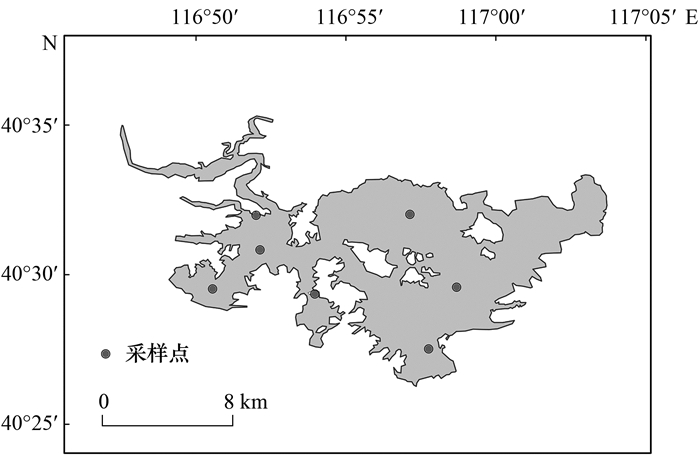
|
图 1 密云水库采样点分布示意 Fig. 1 Distribution of the sampling sites in the Miyun Reservoir |
使用试剂盒FastDNA® SPIN Kit for Soil(MP Biomedicals, USA)提取细菌DNA, 将重复提取所得的DNA提取液混合后进行PCR扩增, 扩增区间为16S rRNA基因的V4-V5区, 扩增引物为338F(5′-ACTCCTACGGGAGGCAGCA-3′)和806R(5′-GGAC TACHVGGGTWTCTAAT-30′)[30].使用Illumina MiSeq PE250测序平台(双端测序250×2)进行测序分析, 测序工作在上海美吉生物医药科技有限公司进行.
1.3 数据处理与分析利用MOTHUR软件(version 1.30.1)计算每个样品中OTUs(operational taxonomic units)分类单元所对应的相对丰度及其α多样性[33], 并使用R语言(version 4.0.3)vegan包进行单因素方差分析(One-way ANOVA), 直观比较细菌群落α多样性的介质差异和季节差异[30].通过R语言基于Bray-Curtis距离算法进行主坐标分析(principal coordinates analysis, PCoA)和相似性分析(analysis of similarity statistics, ANOSIM)对样品的β多样性进行探究, 检验不同分组间差异的显著性[29, 34].使用R语言circlize包绘制不同组别样本与物种的关系圈图(Circos), 对不同样本分组与优势类群之间的对应关系进行可视化[35].使用多级物种差异判别分析(linear discriminant analysis effect size, LEfSe)判别不同分组下的关键物种, 研究细菌群落的空间异质性[36], 选取相对丰度大于0.001的属, LDA阈值设为3.0.为了更直观深入地探明不同细菌之间的相互作用规律, 使用Gephi软件(version 0.9.2)对属水平细菌绘制共存网络图[37], 参数设置为|R|>0.9, P<0.01.使用单因素方差分析比较水体和沉积物环境中, 不同季节环境因子的差异性.使用R语言vegan包进行冗余分析(redundancy analysis, RDA), 研究细菌群落和环境因子间的关系[3].通过SPSS Statistics 19软件计算不同分组下属水平优势细菌和环境因子间的Spearman相关系数[38], 通过R语言pheatmap包可视化绘制相关性热图(Heatmap).
2 结果与分析 2.1 细菌群落的α多样性分析对样品细菌群落的α多样性进行单因素方差分析, 反映密云水库细菌群落的介质差异性和季节差异性.如图 2所示, 水体和沉积物细菌群落的α多样性差异性明显, 沉积物细菌群落在丰富度和Shannon多样性指数上均显著高于水体细菌群落(P<0.01), 此外, 水体细菌群落季节差异显著(P<0.05), 沉积物细菌群落则不存在明显的季节差异(P>0.05).
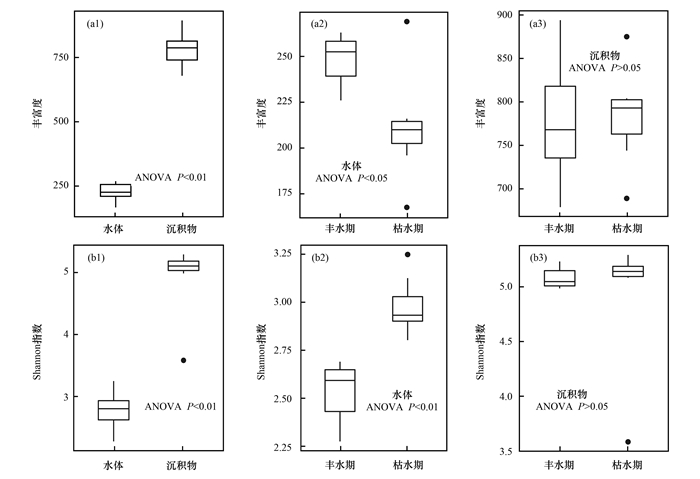
|
(a)丰富度, (b)Shannon多样性指数 图 2 密云水库细菌群落α多样性在不同介质和季节上的单因素方差分析 Fig. 2 One-way ANOVA of the alpha diversity of bacterial communities in the Miyun Reservoir on different media and seasons |
图 3(a)和3(b)为密云水库细菌群落的主坐标分析和相似性分析, 表明各分组间样品的细菌群落组成存在明显差异(R=0.795, P=0.001), 其中细菌群落的介质差异十分显著, 而季节差异在水体细菌群落中显著高于沉积物细菌群落.如图 3(c)和图 3(d)所示, 对不同生境中的主要细菌门和优势细菌属分布进行分析, 放线菌门(Actinobacteriota)主要营浮游生活, 占比最高达30.76%, 其次为变形菌门(Proteobacteria)占比达20.53%, 主要生存在沉积物中.放线菌门的hgcI_clade属和CL500-29_marine_group属在丰水期水体中占据优势, 含量分别为34.31%和24.94%, 蓝藻门(Cyanobacteria)的Cyanobium_PCC-6307属在枯水期水体中含量更高达12.32%.沉积物细菌群落中未出现具有明显生存优势的物种, 同样未发现具有明显季节差异的优势细菌属.
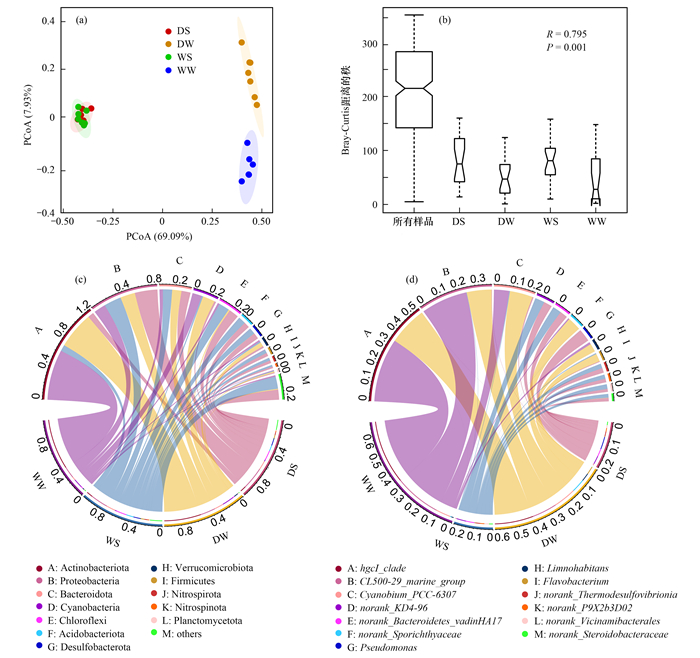
|
(a)主坐标分析(PCoA), (b)相似性分析(ANOSIM), (c)主要细菌门, (d)优势细菌属(>1%); DS:枯水期沉积物, DW:枯水期水体, WS:丰水期沉积物, WW:丰水期水体 图 3 密云水库细菌群落不同生境间的组成和分布差异 Fig. 3 Differences in the composition and distribution of bacterial communities among different habitats in the Miyun Reservoir |
采用LEfSe分析对不同生境条件下显著差异的物种进行深入分析, 寻找优势类群.从图 4(a)可以看出, 密云水库细菌群落的水泥介质差异显著, 沉积物中的关键物种数目远高于水体.沉积物细菌群落主要的指示物种为绿弯菌门(Chloroflexi)的norank_KD4-96属和拟杆菌门(Bacteroidota)的norank_Bacteroidetes_vadinHA17属, 水体细菌群落的指示物种为放线菌门的hgcI_clade属和CL500-29_marine_group属.如图 4(b)所示, 水体细菌群落在不同季节间的分布同样存在显著差异性, 枯水期优势类群数目略高于丰水期, 枯水期关键物种为放线菌门的norank_Sporichthyaceae属和拟杆菌门的Flavobacterium属, 丰水期关键物种为hgcI_clade属.沉积物细菌群落则不存在显著的季节差异物种和明显的季节差异性.
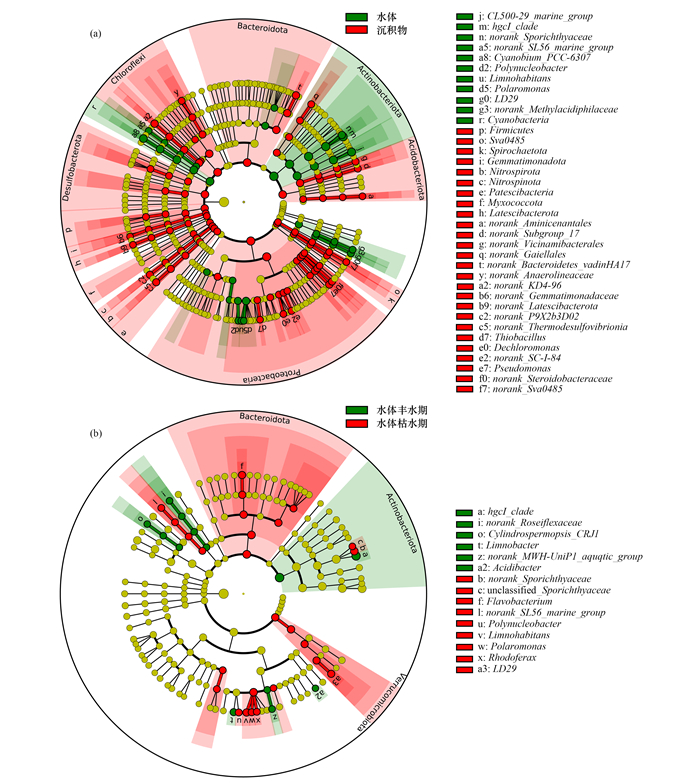
|
(a)介质差异, (b)水体细菌季节差异 图 4 密云水库不同生境中细菌群落的线性判别分析分支图(LEfSe) Fig. 4 Linear discriminant analysis effect size (LEfSe) cladograms among different habitats in the Miyun Reservoir bacterial communities |
通过物种共现性网络分析反映细菌属水平上的相互作用情况.如图 5(a)和5(b)所示, 水体细菌群落整体的共存关系较沉积物细菌群落复杂, 各模块占比较大且内部集中程度高, 沉积物细菌群落各模块占比较为平均且分散.整体细菌群落间的网络关系以正相关为主, 水体细菌间的正相关关系多于沉积物细菌.水体细菌模块Ⅰ占比最高为19.65%, 变形菌门在该模块中起到关键性作用, 占比达41.79%, 其余细菌主要来自拟杆菌门、Myxococcota门、蓝藻门和绿弯菌门等.沉积物细菌群落中连接度最大的是模块Ⅱ中Myxococcota门的norank_Sandaracinaceae属, 作为关键类群主要与多个变形菌门细菌呈现较高的相关性.
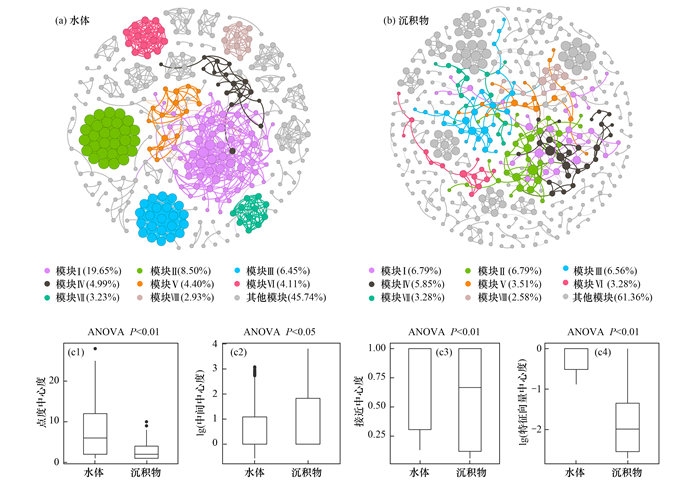
|
(a)水体细菌共存网络, (b)沉积物细菌共存网络, (c)拓扑特性差异 图 5 密云水库中细菌群落的共存网络关系 Fig. 5 Co-occurrence networks for bacterial communities in the Miyun Reservoir |
如图 5(c)所示, 对比两种介质下的网络拓扑特性可以发现, 水泥介质间细菌群落的共存关系存在显著差异, 水体细菌间的点度中心度、接近中心度和特征向量中心度高于沉积物细菌, 中间中心度则略低于沉积物细菌.
2.3 细菌群落与环境因子的相关性分析密云水库不同生境环境因子的分布情况见表 1.如图 6所示, 进一步对采样点所有环境因子进行季节性差异分析, 水体中TP(P<0.05)和DP(P<0.05)质量浓度在枯水期更高, SO42-(P<0.01)和TOC(P<0.05)质量浓度在丰水期更高, 沉积物中NH4+-N(P<0.01)在丰水期含量更高, TOC(P<0.05)在枯水期含量更高.
|
|
表 1 密云水库不同生境环境因子分布情况1) Table 1 Distribution of environmental factors in different habitats of the Miyun Reservoir |
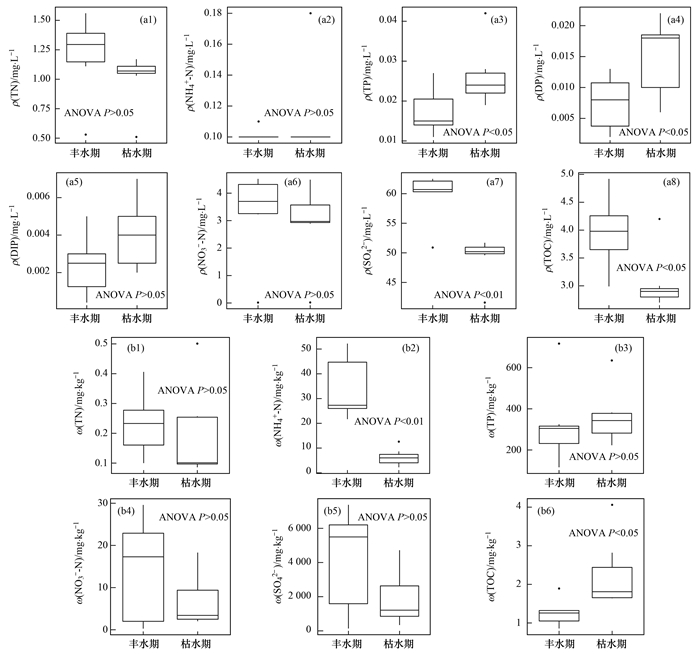
|
(a)水体, (b)沉积物 图 6 密云水库相关环境因子的分布和季节变化 Fig. 6 Distribution and seasonal variation in environmental factors in the Miyun Reservoir |
通过冗余分析对细菌群落与环境因子间的相关性进行探究, 对比图 7(a)和7(b)可知, 水体样本点依据季节呈现明显聚集, 沉积物样本点则呈现分散状态, 再次证明水体细菌群落具有明显季节差异, 而沉积物细菌群落季节差异不明显, 这一结果与前述结论相一致.影响水体细菌群落的主要环境因子为SO42-(r2=0.704 4, P=0.006)、TOC(r2=0.524 6, P=0.021)和TP(r2=0.473 3, P=0.029), 其中枯水期水体细菌群落与SO42-和TOC呈现负相关, 与TP呈现正相关关系.沉积物细菌群落中, 仅有TN(r2=0.766 0, P=0.002)和SO42-(r2=0.449 3, P=0.048)体现出较强的相关性.
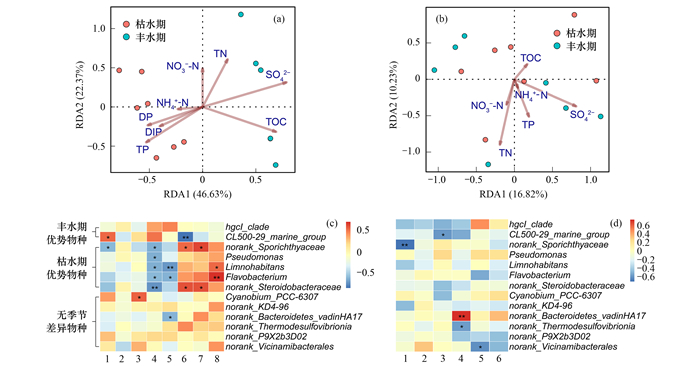
|
(a)水体细菌群落冗余分析, (b)沉积物细菌群落冗余分析, (c)水体优势细菌属热图, (d)沉积物优势细菌属热图; 1.TN, 2.NH4+-N, 3.NO3--N, 4.SO42-, 5.TOC, 6.TP, 7.DP, 8.DIP 图 7 密云水库细菌群落和属水平优势细菌与环境因子间的相关性 Fig. 7 Correlation between bacterial communities, dominant bacteria at genus level, and environmental factors in the Miyun Reservoir |
进一步探究外界理化条件对于细菌群落中关键物种的影响, 对比图 7(c)和7(d)可知, 环境因子对于水体细菌的影响显著高于沉积物细菌.水体中, norank_Sporichthyaceae属与多个环境因子呈现明显相关性, 对外界环境变化敏感, SO42-对于细菌群落影响最大, 与多个优势物种呈现显著负相关.沉积物中, norank_Sporichthyaceae属则与TN呈现显著负相关(r2=-0.678, P<0.01), norank_Bacteroidetes_vadinHA 17属与SO42-呈现显著正相关(r2=0.789, P<0.01).此外, 水体环境中优势细菌属与环境因子间的相关性呈现出明显的季节性分布, 而沉积物中则不存在显著的季节性差异.
3 讨论 3.1 密云水库细菌群落的水泥介质差异分析沉积物的水平扩散能力远低于水体, 因而具有更加多样化的生境特征, 能够支持更多物种生存, 并且沉积物环境更加适于细菌附着繁殖, 减少相互竞争[16], 从而造成沉积物中含有更加丰富多样的细菌种类和更为均匀的丰度分布, 增加了群落的α多样性, 表明沉积物细菌群落能够表现出更高的系统发育多样性[39].在密云水库水体细菌群落中, 放线菌门的hgcI_clade属、CL500-29_marine_group属和蓝藻门的Cyanobium_PCC-6307属具有显著优势, 主要营浮游生活, 其中CL500-29_marine_group属被证明在水质进化中发挥着主导作用[40].沉积物细菌群落可能由于沉积物环境与外部环境间的相互作用少, 受外界环境因子变化干扰小, 流动性弱于水体[16], 因而沉积物细菌群落受季节变化影响不明显.
共存网络关系可以用于直观比较不同分组条件下物种间的相互关系, 模块化程度代表了物种间作用关系的强弱, 模块化能力越强表明该条件下网络结构和物种间的作用关系更为复杂[39].密云水库细菌群落的共存网络关系表明, 水体细菌群落间的共存关系较沉积物更为紧密和复杂, 此外细菌群落中其他模块占比较高, 说明由于水库水体流动性差且物质交换少, 降低了细菌间相互作用的可能[22], 其中沉积物中其他模块占比达到61.36%, 显著高于水体中其他模块的含量(45.74%), 即沉积物的模块化能力较弱, 这可能是由于沉积物扩散性弱于水体, 同时受环境因子波动的影响小, 不需要形成类似水体的联系紧密的大模块用于抵御外界因素变化的影响, 因此细菌在该生境中的生存方式更加独立, 相互间联系松散, 不同细菌间的作用和影响更小, 造成整体模块小而独立, 且其他非优势模块在整体中占比高于水体的现象[39].
3.2 密云水库细菌群落的物种组成差异微生物的环境特异性表明, 细菌群落可能是地球物理化学特征转变的生物指示物, 细菌群落的广泛分布已经成为其重要的生态特征之一, 表明细菌对不同的环境具有灵活的适应能力[41].Wang等[42]的研究表明不同样点的细菌群落按其原始生境类型相互聚类, 不同生境类型间的细菌群落系统发育差异显著高于同一生境类型内的差异, 因此密云水库细菌群落呈现介质差异性显著高于季节差异性的现象.
密云水库沉积物细菌群落中的主要优势物种为绿弯菌门、变形菌门、酸杆菌门(Acidobacteriota)、Desulfobacterota门和拟杆菌门, 水体细菌群落的主要优势物种则为放线菌门和蓝藻门, 上述物种在已有研究中常作为细菌群落中的主要优势类群被检出[43~46].绿弯菌门常见于多种环境沉积物样品[43], 并且在水体环境中的丰度显著低于沉积物环境, Eraqi等[44]在对尼罗河冬夏两季水体和沉积物细菌群落进行测序的过程中发现, 绿弯菌门在水体细菌群落中不作为优势物种出现, 而在沉积物环境中平均丰度达4.95%.同样的, 酸杆菌门细菌物种高度多样化, 并栖息在地球上的各类生境中[47], 尤其是在土壤和沉积物中十分普遍, 常作为关键物种主导微生物群落的构建[46], Kielak等[48]分析酸杆菌门的宏基因组数据, 发现其具有多种适应土壤和沉积物环境的生态功能, 从而在该环境中拥有较强的竞争力.酸杆菌门和变形菌门在环境中常被观察到具有密切的生态学关系[47, 49], 能够共同影响细菌群落的组成和构建.密云水库枯水期水体中疣微菌门和拟杆菌门的优势同步上升, 陈倩茹等[50]对沙颍河沉积物研究时发现, 在较为干旱的秋季, 上述两者在沉积物中的相对丰度均同步减小, 而Fries等[15]探究了细菌在纽斯河口水体和沉积物环境间的交换过程, 发现沉积物再悬浮是水体细菌的一个重要来源, 因此该作用可能造成密云水库中疣微菌门和拟杆菌门从沉积物交换至水体, 从而在枯水期水体中占据显著优势.
密云水库整体细菌群落间的网络关系以正相关为主, 水体细菌间的正相关关系多于沉积物细菌, 水体细菌群落的共存网络同样具有更多的节点和更为复杂的关系, 表明在水体中细菌间可能存在更加广泛的相互作用[51], 因此具有更强的抵抗外界环境变化的能力[39].关键物种是群落结构和生态系统稳定的驱动因素[52], 能够影响整体细菌群落代谢的网络结构[53], 关键类群的消失甚至可能导致网络结构的崩溃[39].沉积物中Myxococcota门的norank_Sandaracinaceae属与多个细菌间存在相互作用, 已有研究表明该属对土壤有机质具有正向偏好性[54], 拟杆菌门的Flavobacteriaceae科降解大分子的能力有限, 但可以与Myxococcota门的Sandaracinaceae科和酸杆菌门细菌共同作用, 从低分子化合物中获取能量[55].
3.3 密云水库水体细菌群落的季节差异分析密云水库蓄水量的季节性波动导致水体细菌群落发生变化, 枯水期和丰水期不同的降水模式直接影响了水体细菌群落的物种组成[29], 而沉积物环境通过长期的泥沙侵蚀和沉降堆积过程达到平衡状态, 因而沉积物细菌群落的季节性变化不如水体细菌群落显著[56].在现有的淡水生态系统研究中, 放线菌门和变形菌门常作为优势细菌门出现[57, 58], 其中放线菌门的细菌主要呈现自由态, 与悬浮颗粒浓度呈负相关[59], 密云水库放线菌门于丰水期水体中大量存在, 这可能与丰水期蓄水量增大, 造成悬浮颗粒浓度降低有关[60].放线菌门的hgcI_clade属和CL500-29_marine_group属同样也是常见的淡水生态系统水体细菌优势属, 并且二者具有相似的时空变化趋势[58, 61], 其中hgcI_clade属被认为是一类新的潜在的关键细菌类群, 在全球范围内长期存在于寡营养水生生态系统中[62], 丰度高而稳定[63].枯水期水库蓄水量减少, 整体营养物质浓度升高, 水体流动减缓, 不利于放线菌门细菌的繁殖增长, 与之相反, 蓝藻门的Cyanobium_PCC-6307属在水体营养物质含量较高的情况下依然生长良好, 逐渐成为水体细菌群落中的优势物种[56].水体中的蓝细菌能够进行光合作用, 在生长过程中向周围环境释放大量的次生代谢物如溶解性有机碳等, 造成水中有机物浓度快速上升, 进而可能引起水华现象污染水库水质[64].因此在水库日常监测的过程中, 一方面应注意水中营养物质浓度的变化情况, 另一方面应提前做好准备, 应对潜在的蓝藻水华危害.
3.4 密云水库细菌群落与环境因子的关系密云水库细菌群落主要受SO42-浓度、营养物质浓度(如TP、TN等)和TOC等外界环境因素的影响.Shi等[65]对澜沧江水体和沉积物细菌进行测序分析时发现, 硫酸盐还原菌主要来自于放线菌门、变形菌门和拟杆菌门, 与本研究一致, 并且几乎所有硫酸盐还原菌在水体环境中与SO42-浓度呈负相关, 在沉积物环境中呈正相关, 表明SO42-浓度对于细菌群落的组成和分布具有重要作用.TP是水体和沉积物中细菌群落结构的决定性因素之一, 变形菌门作为本研究中最为优势的物种, 受TP影响显著, 这一结果与Wu等[38]的研究相一致.变形菌门的假单胞菌属(Pseudomonas)是重要的反硝化细菌之一, 同时也是密云水库中的优势细菌属, 环境中TN和TP是影响反硝化细菌的主要因素, 细菌群落易受到外界TN和TP的影响从而改变整体的结构和功能[66, 67].放线菌门细菌能够帮助分解死亡生物体中的有机物, 使植物能够重新吸收利用这些分子, 部分放线菌作为共生菌广泛存在于植物根部, 具有固定碳源和从中获取养分的能力[68], 因此与TOC具有明显的正相关性, 并且TOC是微生物生长代谢的能量来源, 环境中存在高浓度的TOC有利于提高细菌群落的多样性[34].此外, 放线菌一般分布在世界各地的淡水生态系统中, 常见于寡营养水体[69], Zeng等[70]曾报道放线菌在水体微生物群落中的占比与水体中含氮化合物的含量呈现负相关性, 多项研究表明放线菌具有对水体进行消毒、改善气味、抑制致病微生物、转化N和P等多种生态功能[71].
3.5 密云水库与其他水库细菌群落的相似性分析Li等[72]对长江三峡水库库区内水体细菌群落的时空分布格局进行研究, 所得结论与本研究中密云水库细菌群落结构较为相似, 即变形菌门和放线菌门占主导地位, 其次为拟杆菌门和蓝藻门, hgcI_clade属同样也被鉴定为含量最高的细菌属.以往大量关于水库中细菌群落的研究均揭示了hgcI_clade属的优势地位[73, 74], 此细菌隶属于放线菌门, 在广泛的淡水生境中十分常见, 并且容易受到水体气味的影响, 可以反映水库水质的变化情况[75].同时, 已有研究表明hgcI_clade属具有很强的遗传能力, 可以摄取富含氮和碳水化合物的有机物为自身提供能量[76], 还可以通过功能基因利用太阳光促进碳的回补固定, 表明该细菌属可能具有自养和异养两种生活方式[77], 因此在水流较为缓慢、光照充足稳定、营养物质含量不高的饮用水水库中, 该属占据明显的优势地位.此外, Xu等[78]对上海和新加坡多个河口水库进行综合分析, 同样发现了与密云水库相似的细菌分布情况, 即河口水库中放线菌门的hgcI_clade属和CL500-29_marine_group属在高温多雨的夏季丰水期相对丰度显著上升, 这可能归因于放线菌对于紫外线有较高的耐受性[79], 因此在流动性较低的水库环境下, 尤其是在夏季丰水期中, 占据明显的优势.
4 结论(1) 密云水库沉积物细菌群落较水体细菌群落有着更高的α多样性, 不同生境下的细菌群落具有显著的组间差异性和β多样性, 其中细菌群落的介质差异明显, 季节差异在水体细菌群落中显著高于沉积物细菌群落.
(2) 密云水库不同生境间细菌群落的物种组成存在差异性, 放线菌门的hgcI_clade属和CL500-29_marine_group属在丰水期水体中占主导地位, 蓝藻门的Cyanobium_PCC-6307属在枯水期水体中占主导地位, 沉积物细菌群落中不存在明显的优势物种.
(3) 密云水库水体细菌群落不同季节的优势类群不同, 沉积物细菌群落较水体细菌群落具有更多指示物种, 并且不存在显著的季节差异物种和明显的季节差异性.
(4) 细菌群落间的网络关系以正相关为主, 水体细菌群落的共现性网络存在更多节点和更加复杂的相关关系, 较沉积物细菌群落具有更强的抵抗外界环境变化的能力.
(5) 影响水体细菌群落的主要环境因子为SO42-、TOC和TP, 沉积物细菌群落的主要影响因子为TN, 外界环境条件对于水体细菌优势属的影响显著高于沉积物细菌.
| [1] | Yu Z, Yang J, Zhou J, et al. Water stratification affects the microeukaryotic community in a subtropical deep reservoir[J]. Journal of Eukaryotic Microbiology, 2014, 61(2): 126-133. DOI:10.1111/jeu.12090 |
| [2] | Yan M M, Chen S N, Huang T L, et al. Community compositions of phytoplankton and eukaryotes during the mixing periods of a drinking water reservoir: Dynamics and interactions[J]. International Journal of Environmental Research and Public Health, 2020, 17(4). DOI:10.3390/ijerph17041128 |
| [3] | Zhang H H, Jia J Y, Chen S N, et al. Dynamics of bacterial and fungal communities during the outbreak and decline of an algal bloom in a drinking water reservoir[J]. International Journal of Environmental Research and Public Health, 2018, 15(2). DOI:10.3390/ijerph15020361 |
| [4] |
马越, 郭庆林, 黄廷林, 等. 西安黑河金盆水库季节性热分层的水质响应特征[J]. 水利学报, 2013, 44(4): 406-415. Ma Y, Guo Q L, Huang T L, et al. Response characteristics of water quality to the seasonal thermal stratification in Jin-pen reservoir along the Heihe river, Xi'an city in China[J]. Journal of Hydraulic Engineering, 2013, 44(4): 406-415. DOI:10.3969/j.issn.0559-9350.2013.04.006 |
| [5] | Röske K, Röske I, Uhlmann D. Characterization of the bacterial population and chemistry in the bottom sediment of a laterally subdivided drinking water reservoir system[J]. Limnologica, 2008, 38(3-4): 367-377. DOI:10.1016/j.limno.2008.06.005 |
| [6] | Röske K, Sachse R, Scheerer C, et al. Microbial diversity and composition of the sediment in the drinking water reservoir Saidenbach (Saxonia, Germany)[J]. Systematic and Applied Microbiology, 2012, 35(1): 35-44. DOI:10.1016/j.syapm.2011.09.002 |
| [7] |
闫苗苗, 陈胜男, 黄廷林, 等. 分层型水库藻类垂向演替的水质与细菌种群调控[J]. 环境科学, 2020, 41(7): 3285-3296. Yan M M, Chen S N, Huang T L, et al. Water quality and bacterial population driving mechanism of algae vertical succession in stratified reservoir[J]. Environmental Science, 2020, 41(7): 3285-3296. DOI:10.13227/j.hjkx.202001131 |
| [8] |
闫苗苗, 张海涵, 黄廷林, 等. 分层型水库藻类季相演替的细菌种群驱动机制[J]. 环境科学, 2021, 42(1): 221-233. Yan M M, Zhang H H, Huang T L, et al. Mechanism of algal community dynamics driven by the seasonal water bacterial community in a stratified drinking water reservoir[J]. Environmental Science, 2021, 42(1): 221-233. DOI:10.13227/j.hjkx.202006234 |
| [9] | Arrigo K R. Marine microorganisms and global nutrient cycles[J]. Nature, 2005, 437(7057): 349-355. DOI:10.1038/nature04159 |
| [10] |
张强, 孟远航, Wang J. 美国俄亥俄河流域水质卫生委员会的运作[J]. 世界环境, 2016(1): 31-33. Zhang Q, Meng Y H, Wang J. Operation of the Ohio river valley water sanitation commission[J]. World Environment, 2016(1): 31-33. |
| [11] |
辛胜林, 梁月明, 彭文杰, 等. 亚热带典型岩溶水库细菌丰度和细菌生产力及其与环境因子的关系[J]. 环境科学, 2018, 39(12): 5647-5656. Xin S L, Liang Y M, Peng W J, et al. Relationship between the bacterial abundance and production with environmental factors in a subtropical karst reservoir[J]. Environmental Science, 2018, 39(12): 5647-5656. DOI:10.13227/j.hjkx.201804227 |
| [12] | Zhang H H, Chen S N, Huang T L, et al. Vertical distribution of bacterial community diversity and water quality during the reservoir thermal stratification[J]. International Journal of Environmental Research and Public Health, 2015, 12(6): 6933-6945. DOI:10.3390/ijerph120606933 |
| [13] |
王禹冰, 王晓燕, 庞树江, 等. 水库水体热分层的水质及细菌群落分布特征[J]. 环境科学, 2019, 40(6): 2745-2752. Wang Y B, Wang X Y, Pang S J, et al. Water quality characteristics and distribution of bacterial communities during thermal stratification in the Miyun Reservoir[J]. Environmental Science, 2019, 40(6): 2745-2752. DOI:10.13227/j.hjkx.201809074 |
| [14] | Zhang H H, Huang T L, Liu T T. Sediment enzyme activities and microbial community diversity in an oligotrophic drinking water reservoir, Eastern China[J]. PLoS One, 2013, 8(10). DOI:10.1371/journal.pone.0078571 |
| [15] | Fries J S, Characklis G W, Noble R T. Sediment-water exchange of Vibrio sp. and fecal indicator bacteria: Implications for persistence and transport in the Neuse River Estuary, North Carolina, USA[J]. Water Research, 2008, 42(4-5): 941-950. DOI:10.1016/j.watres.2007.09.006 |
| [16] |
彭柯, 董志, 邸琰茗, 等. 基于16S rRNA高通量测序的北运河水体及沉积物微生物群落组成对比分析[J]. 环境科学, 2021, 42(11): 5424-5432. Peng K, Dong Z, Di Y M, et al. Contrasting analysis of microbial community composition in the water and sediments of the North Canal based on 16S rRNA high-throughput sequencing[J]. Environmental Science, 2021, 42(11): 5424-5432. |
| [17] | Wang S, Hou W G, Jiang H C, et al. Microbial diversity accumulates in a downstream direction in the Three Gorges Reservoir[J]. Journal of Environmental Sciences, 2021, 101: 156-167. DOI:10.1016/j.jes.2020.08.006 |
| [18] | Wu H P, Zeng G M, Liang J, et al. Changes of soil microbial biomass and bacterial community structure in Dongting Lake: Impacts of 50, 000 dams of Yangtze River[J]. Ecological Engineering, 2013, 57: 72-78. DOI:10.1016/j.ecoleng.2013.04.038 |
| [19] |
朱金山, 秦海兰, 孙启耀, 等. 冬季小流域水体微生物多样性及影响因素[J]. 环境科学, 2020, 41(11): 5016-5026. Zhu J S, Qi H L, Sun Q Y, et al. Microbial diversity and influencing factors in a small watershed in winter[J]. Environmental Science, 2020, 41(11): 5016-5026. DOI:10.13227/j.hjkx.202003045 |
| [20] | Reitter C, Petzoldt H, Korth A, et al. Seasonal dynamics in the number and composition of coliform bacteria in drinking water reservoirs[J]. Science of the Total Environment, 2021, 787. DOI:10.1016/j.scitotenv.2021.147539 |
| [21] | Hong H C, Qiu J W, Liang Y. Environmental factors influencing the distribution of total and fecal coliform bacteria in six water storage reservoirs in the Pearl River Delta Region, China[J]. Journal of Environmental Sciences, 2010, 22(5): 663-668. DOI:10.1016/S1001-0742(09)60160-1 |
| [22] | Zhou S L, Sun Y, Huang T L, et al. Reservoir water stratification and mixing affects microbial community structure and functional community composition in a stratified drinking reservoir[J]. Journal of Environmental Management, 2020, 267. DOI:10.1016/j.jenvman.2020.110456 |
| [23] | Qu J Q, Xu R J, Yang H C, et al. Community structure of two rotifer populations and ecological assessment of water quality in Miyun Reservoir[J]. IOP Conference Series: Earth and Environmental Science, 2021, 829(1). DOI:10.1088/1755-1315/829/1/012018 |
| [24] |
王媛媛, 张俊娥, 王永刚, 等. 南水北调后密云水库水生生物群落结构特征分析——以浮游生物及底栖动物为例[J]. 环境污染与防治, 2021, 43(5): 620-625, 668. Wang Y Y, Zhang J E, Wang Y G, et al. Analysis on characteristics of aquatic organisms community structure in Miyun Reservoir after the South-to-North Water Diversion Project: taking plankton and benthonic animal for example[J]. Environmental Pollution & Control, 2021, 43(5): 620-625, 668. DOI:10.15985/j.cnki.1001-3865.2021.05.017 |
| [25] | Su M, Yu J W, Pan S L, et al. Spatial and temporal variations of two cyanobacteria in the mesotrophic Miyun reservoir, China[J]. Journal of Environmental Sciences, 2014, 26(2): 289-298. DOI:10.1016/S1001-0742(13)60433-7 |
| [26] |
王晓丹, 翟振华, 赵爽, 等. 密云水库不同季节细菌群落多样性[J]. 生态学报, 2009, 29(7): 3919-3927. Wang X D, Zhao Z H, Zhao S, et al. The bacterial diversity in different seasons of Miyun Reservoir[J]. Acta Ecologica Sinica, 2009, 29(7): 3919-3927. DOI:10.3321/j.issn:1000-0933.2009.07.055 |
| [27] | Pei S, Zhang C X, Liu C L, et al. Forest ecological compensation standard based on spatial flowing of water services in the upper reaches of Miyun Reservoir, China[J]. Ecosystem Services, 2019, 39. DOI:10.1016/j.ecoser.2019.100983 |
| [28] | Jiang Q O, Xu L D, Sun S Y, et al. Retrieval model for total nitrogen concentration based on UAV hyper spectral remote sensing data and machine learning algorithms-a case study in the Miyun Reservoir, China[J]. Ecological Indicators, 2021, 124. DOI:10.1016/j.ecolind.2021.107356 |
| [29] | Liu T, Zhang A N, Wang J W, et al. Integrated biogeography of planktonic and sedimentary bacterial communities in the Yangtze River[J]. Microbiome, 2018, 6(1): 16. DOI:10.1186/s40168-017-0388-x |
| [30] | Wang J W, Liu T, Sun W L, et al. Bioavailable metal(loid)s and physicochemical features co-mediating microbial communities at combined metal(loid) pollution sites[J]. Chemosphere, 2020, 260. DOI:10.1016/j.chemosphere.2020.127619 |
| [31] | Wang J W, Chen Y, Cai P G, et al. Impacts of municipal wastewater treatment plant discharge on microbial community structure and function of the receiving river in Northwest Tibetan Plateau[J]. Journal of Hazardous Materials, 2022, 423. DOI:10.1016/j.jhazmat.2021.127170 |
| [32] | Wang J W, Liu Q X, Zhao X F, et al. Molecular biogeography of planktonic and benthic diatoms in the Yangtze River[J]. Microbiome, 2019, 7(1): 153. DOI:10.1186/s40168-019-0771-x |
| [33] | Schloss P D, Westcott S L, Ryabin T, et al. Introducing mothur: open-source, platform-independent, community-supported software for describing and comparing microbial communities[J]. Applied and Environmental Microbiology, 2009, 75(23): 7537-7541. DOI:10.1128/AEM.01541-09 |
| [34] | Meng L, Zuo R, Wang J S, et al. The spatial variations of correlation between microbial diversity and groundwater quality derived from a riverbank filtration site, northeast China[J]. Science of the Total Environment, 2020, 706. DOI:10.1016/j.scitotenv.2019.135855 |
| [35] | Gu Z G, Gu L, Eils R, et al. Circlize implements and enhances circular visualization in R[J]. Bioinformatics, 2014, 30(19): 2811-2812. DOI:10.1093/bioinformatics/btu393 |
| [36] | Segata N, Izard J, Waldron L, et al. Metagenomic biomarker discovery and explanation[J]. Genome Biology, 2011, 12(6). DOI:10.1186/gb-2011-12-6-r60 |
| [37] | Wang L F, Tong J X, Li Y, et al. Bacterial and fungal assemblages and functions associated with biofilms differ between diverse types of plastic debris in a freshwater system[J]. Environmental Research, 2021, 196. DOI:10.1016/j.envres.2020.110371 |
| [38] | Wu S J, Li R L, Xie S G, et al. Depth-related change of sulfate-reducing bacteria community in mangrove sediments: the influence of heavy metal contamination[J]. Marine Pollution Bulletin, 2019, 140: 443-450. DOI:10.1016/j.marpolbul.2019.01.042 |
| [39] | Zhang L Y, Delgado-Baquerizo M, Shi Y, et al. Co-existing water and sediment bacteria are driven by contrasting environmental factors across glacier-fed aquatic systems[J]. Water Research, 2021, 198. DOI:10.1016/j.watres.2021.117139 |
| [40] |
陈兆进, 丁传雨, 朱静亚, 等. 丹江口水库枯水期浮游细菌群落组成及影响因素研究[J]. 中国环境科学, 2017, 37(1): 336-344. Chen Z J, Ding C Y, Zhu J Y, et al. Community structure and influencing factors of bacterioplankton during low water periods in Danjiangkou Reservoir[J]. China Environmental Science, 2017, 37(1): 336-344. |
| [41] | Liu X, Hu H W, Liu Y R, et al. Bacterial composition and spatiotemporal variation in sediments of Jiaozhou Bay, China[J]. Journal of Soils and Sediments, 2015, 15(3): 732-744. DOI:10.1007/s11368-014-1045-7 |
| [42] | Wang J J, Shen J, Wu Y C, et al. Phylogenetic beta diversity in bacterial assemblages across ecosystems: deterministic versus stochastic processes[J]. The ISME Journal, 2013, 7(7): 1310-1321. DOI:10.1038/ismej.2013.30 |
| [43] | Maintinguer S I, Sakamoto I K, Adorno M A T, et al. Diversity of anaerobic bacteria in sediments from a subtropical reservoir[J]. Lakes & Reservoirs: Science, Policy and Management for Sustainable Use, 2016, 21(4): 351-361. |
| [44] | Eraqi W A, ElRakaiby M T, Megahed S A, et al. Spatiotemporal analysis of the water and sediment Nile microbial community along an urban metropolis[J]. Microbial Ecology, 2021, 82(2): 288-298. DOI:10.1007/s00248-020-01674-8 |
| [45] | Eichorst S A, Trojan D, Roux S, et al. Genomic insights into the Acidobacteria reveal strategies for their success in terrestrial environments[J]. Environmental Microbiology, 2018, 20(3): 1041-1063. DOI:10.1111/1462-2920.14043 |
| [46] | Flieder M, Buongiorno J, Herbold C W, et al. Novel taxa of Acidobacteriota implicated in seafloor sulfur cycling[J]. The ISME Journal, 2021, 15(11): 3159-3180. |
| [47] | Muyzer G, Stams A J M. The ecology and biotechnology of sulphate-reducing bacteria[J]. Nature Reviews Microbiology, 2008, 6(6): 441-454. |
| [48] | Kielak A M, Barreto C C, Kowalchuk G A, et al. The ecology of Acidobacteria: moving beyond genes and genomes[J]. Frontiers in Microbiology, 2016, 7. DOI:10.3389/fmicb.2016.00744 |
| [49] | Meisinger D B, Zimmermann J, Ludwig W, et al. In situ detection of novel Acidobacteria in microbial mats from a chemolithoautotrophically based cave ecosystem (Lower Kane Cave, WY, USA)[J]. Environmental Microbiology, 2007, 9(6): 1523-1534. |
| [50] |
陈倩茹, 夏雪, 王川, 等. 沙颍河下游城市黑臭内河沉积物微生物群落季节变化特征[J]. 水生生物学报, 2021, 45(1): 182-189. Chen Q R, Xia X, Wang C, et al. Seasonal variation characteristics of microbial communities in the sediments of urban black-odorous river in lower reaches of Shaying River[J]. Acta Hydrobiologica Sinica, 2021, 45(1): 182-189. |
| [51] | Rong L L, Wu X H, Xu J, et al. Clomazone improves the interactions between soil microbes and affects C and N cycling functions[J]. Science of the Total Environment, 2021, 770. DOI:10.1016/j.scitotenv.2020.144730 |
| [52] | Banerjee S, Schlaeppi K, Van Der Heijden M G A. Keystone taxa as drivers of microbiome structure and functioning[J]. Nature Reviews Microbiology, 2018, 16(9): 567-576. |
| [53] | Rafrafi Y, Trably E, Hamelin J, et al. Sub-dominant bacteria as keystone species in microbial communities producing bio-hydrogen[J]. International Journal of Hydrogen Energy, 2013, 38(12): 4975-4985. |
| [54] | He C, Zeng Q, Chen Y L, et al. Colonization by dark septate endophytes improves the growth and rhizosphere soil microbiome of licorice plants under different water treatments[J]. Applied Soil Ecology, 2021, 166. DOI:10.1016/j.apsoil.2021.103993 |
| [55] | Probandt D, Knittel K, Tegetmeyer H E, et al. Permeability shapes bacterial communities in sublittoral surface sediments[J]. Environmental Microbiology, 2017, 19(4): 1584-1599. |
| [56] | Dang C Y, Wang J W, He Y F, et al. Rare biosphere regulates the planktonic and sedimentary bacteria by disparate ecological processes in a large source water reservoir[J]. Water Research, 2022, 216. DOI:10.1016/j.watres.2022.118296 |
| [57] | Xu Z, Woodhouse J N, Te S H, et al. Seasonal variation in the bacterial community composition of a large estuarine reservoir and response to cyanobacterial proliferation[J]. Chemosphere, 2018, 202: 576-585. |
| [58] | Liu Z G, Iqbal M, Zeng Z B, et al. Comparative analysis of microbial community structure in the ponds with different aquaculture model and fish by high-throughput sequencing[J]. Microbial Pathogenesis, 2020, 142. DOI:10.1016/j.micpath.2020.104101 |
| [59] | Ruiz-González C, Proia L, Ferrera I, et al. Effects of large river dam regulation on bacterioplankton community structure[J]. FEMS Microbiology Ecology, 2013, 84(2): 316-331. |
| [60] | Wang Y, Lu L H, Hong Y G, et al. Divergent responses of taxonomic and predicted functional profiles of bacterioplankton to reservoir impoundment[J]. Environmental Research, 2020, 182. DOI:10.1016/j.envres.2019.109083 |
| [61] | Luo Z X, Li S J, Hou K, et al. Spatial and seasonal bacterioplankton community dynamics in the main channel of the Middle Route of South-to-North Water Diversion Project[J]. Research in Microbiology, 2019, 170(1): 24-34. |
| [62] | Newton R J, Jones S E, Eiler A, et al. A guide to the natural history of freshwater lake bacteria[J]. Microbiology and Molecular Biology Reviews, 2011, 75(1): 14-49. |
| [63] | Ruprecht J E, Birrer S C, Dafforn K A, et al. Wastewater effluents cause microbial community shifts and change trophic status[J]. Water Research, 2021, 200. DOI:10.1016/j.watres.2021.117206 |
| [64] | Yang C Y, Wang Q, Simon P N, et al. Distinct network interactions in particle-associated and free-living bacterial communities during a Microcystis aeruginosa bloom in a plateau lake[J]. Frontiers in Microbiology, 2017, 8. DOI:10.3389/fmicb.2017.01202 |
| [65] | Shi J X, Zhang B G, Wang Y N, et al. Effects of hydropower dam construction on sulfur distribution and sulfate-reducing prokaryotes assemblage[J]. Science of the Total Environment, 2020, 705. DOI:10.1016/j.scitotenv.2019.135819 |
| [66] | Chen Q R, Fan J F, Ming H X, et al. Effects of environmental factors on denitrifying bacteria and functional genes in sediments of Bohai Sea, China[J]. Marine Pollution Bulletin, 2020, 160. DOI:10.1016/j.marpolbul.2020.111621 |
| [67] | Zhou S L, Sun Y, Zhang Y R, et al. Variations in microbial community during nitrogen removal by in situ oxygen-enhanced indigenous nitrogen-removal bacteria[J]. Water Science and Engineering, 2018, 11(4): 276-287. |
| [68] | Yi Y J, Lin C Q, Wang W J, et al. Habitat and seasonal variations in bacterial community structure and diversity in sediments of a Shallow lake[J]. Ecological Indicators, 2021, 120. DOI:10.1016/j.ecolind.2020.106959 |
| [69] | Kolmonen E, Sivonen K, Rapala J, et al. Diversity of cyanobacteria and heterotrophic bacteria in cyanobacterial blooms in Lake Joutikas, Finland[J]. Aquatic Microbial Ecology, 2004, 36: 201-211. |
| [70] | Zeng J, Yang L Y, Du H W, et al. Bacterioplankton community structure in a eutrophic lake in relation to water chemistry[J]. World Journal of Microbiology and Biotechnology, 2009, 25(5): 763-772. |
| [71] | Tang Y T, Zhao L J, Cheng Y X, et al. Control of cyanobacterial blooms in different polyculture patterns of filter feeders and effects of these patterns on water quality and microbial community in aquacultural ponds[J]. Aquaculture, 2021, 542. DOI:10.1016/j.aquaculture.2021.736913 |
| [72] | Li Z, Lu L H, Guo J S, et al. Responses of spatial-temporal dynamics of bacterioplankton community to large-scale reservoir operation: a case study in the Three Gorges Reservoir, China[J]. Scientific Reports, 2017, 7. DOI:10.1038/srep42469 |
| [73] | Sun Z, Li G P, Wang C W, et al. Community dynamics of prokaryotic and eukaryotic microbes in an estuary reservoir[J]. Scientific Reports, 2014, 4. DOI:10.1038/srep06966 |
| [74] | Zhou Z Z, Huang T, Gong W J, et al. Field research on mixing aeration in a drinking water reservoir: performance and microbial community structure[J]. International Journal of Environmental Research and Public Health, 2019, 16(21): 4221. |
| [75] | Klausen C, Nicolaisen M H, Strobel B W, et al. Abundance of actinobacteria and production of geosmin and 2-methylisoborneol in Danish streams and fish ponds[J]. FEMS Microbiology Ecology, 2005, 52(2): 265-278. |
| [76] | Ghylin T W, Garcia S L, Moya F, et al. Comparative single-cell genomics reveals potential ecological niches for the freshwater acI Actinobacteria lineage[J]. The ISME Journal, 2014, 8(12): 2503-2516. |
| [77] | Sharma A K, Sommerfeld K, Bullerjahn G S, et al. Actinorhodopsin genes discovered in diverse freshwater habitats and among cultivated freshwater Actinobacteria[J]. The ISME Journal, 2009, 3(6): 726-737. |
| [78] | Xu Z, Te S H, He Y L, et al. The characteristics and dynamics of cyanobacteria-heterotrophic bacteria between two estuarine reservoirs - tropical versus sub-tropical regions[J]. Frontiers in Microbiology, 2018, 9. DOI:10.3389/fmicb.2018.02531 |
| [79] | Warnecke F, Sommaruga R, Sekar R, et al. Abundances, identity, and growth state of actinobacteria in mountain lakes of different UV transparency[J]. Applied and Environmental Microbiology, 2005, 71(9): 5551-5559. |
 2023, Vol. 44
2023, Vol. 44


